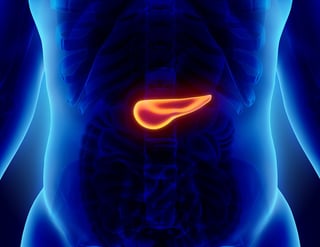
What is exocrine pancreatic insufficiency?
The clinical symptoms of exocrine pancreatic insufficiency are similar to those of many other gastrointestinal disorders and are mainly affected by diet, such as through fat content and insoluble fiber. Low fat diets can often mask exocrine pancreatic insufficiency by reducing steatorrhea which is the excretion of abnormal quantities of fat with the feces owing to reduced absorption of fat by the intestine. Patients will often limit their fat intake to reduce symptoms. Although assessment of clinical symptoms including body weight, BMI and other anthropometric parameters are not sensitive methods for diagnosis; they are helpful in monitoring pancreatic enzyme replacement therapy. Changes in these symptoms appear to be a valid marker of improvement in patients receiving pancreatic replacement therapy. Improvement in clinical symptoms does not necessarily indicate normal nutritional status.
As we age, our body's ability to produce adequate enzymes declines. When patient's have severe pancreatic insufficiency, they can have a nutritional I.V. of glutathione which bypasses the gut. We can add several German biologics to support liver, gallbladder and pancreatic function. All therapies are MD ordered in NYS.
Besides dietary changes and exercise, some patients take Xymogen's Lipotropix and acid-resistant, non-animal dervied PanXyme pH enzymes.
Now that you've got the info, take this quiz to test your knowledge!
1. The clinical symptoms of exocrine pancreatic insufficiency (EPI) are __________.
B. Affected by diet
C. A and B
D. None of the above
2. True or False. Following a low-fat diet can increase steatorrhea, making it easier to diagnose EPI.
A. True
B. False
3. True or False. Clinical symptoms of EPI can be used to monitor the effectiveness of pancreatic enzyme replacement therapy (PERT).
A. True
B. False
4. According to study information, monitoring which of the following clinical symptoms of EPI is/are useful for assessing the effectiveness of PERT in patients with EPI?
A. Bloating
B. Flatulence
C. Stool characteristics
D. A and B
E. All of the above
5. True or False. According to study findings, patients with EPI who received PERT and experienced improvement of clinical symptoms also had normal nutritional status.
A. True
B. False
Answer Key:
1. C. Affected by Diet
2. B. False
3. A. True
4. All of the above
5. B. False
For complete information, see:
Lindkvist B, Phillips ME, Domínguez-Muñoz JE. Clinical, anthropometric and laboratory nutritional markers of pancreatic exocrine insufficiency: Prevalence and diagnostic use. Pancreatology. 2015;15(6):589-597.



